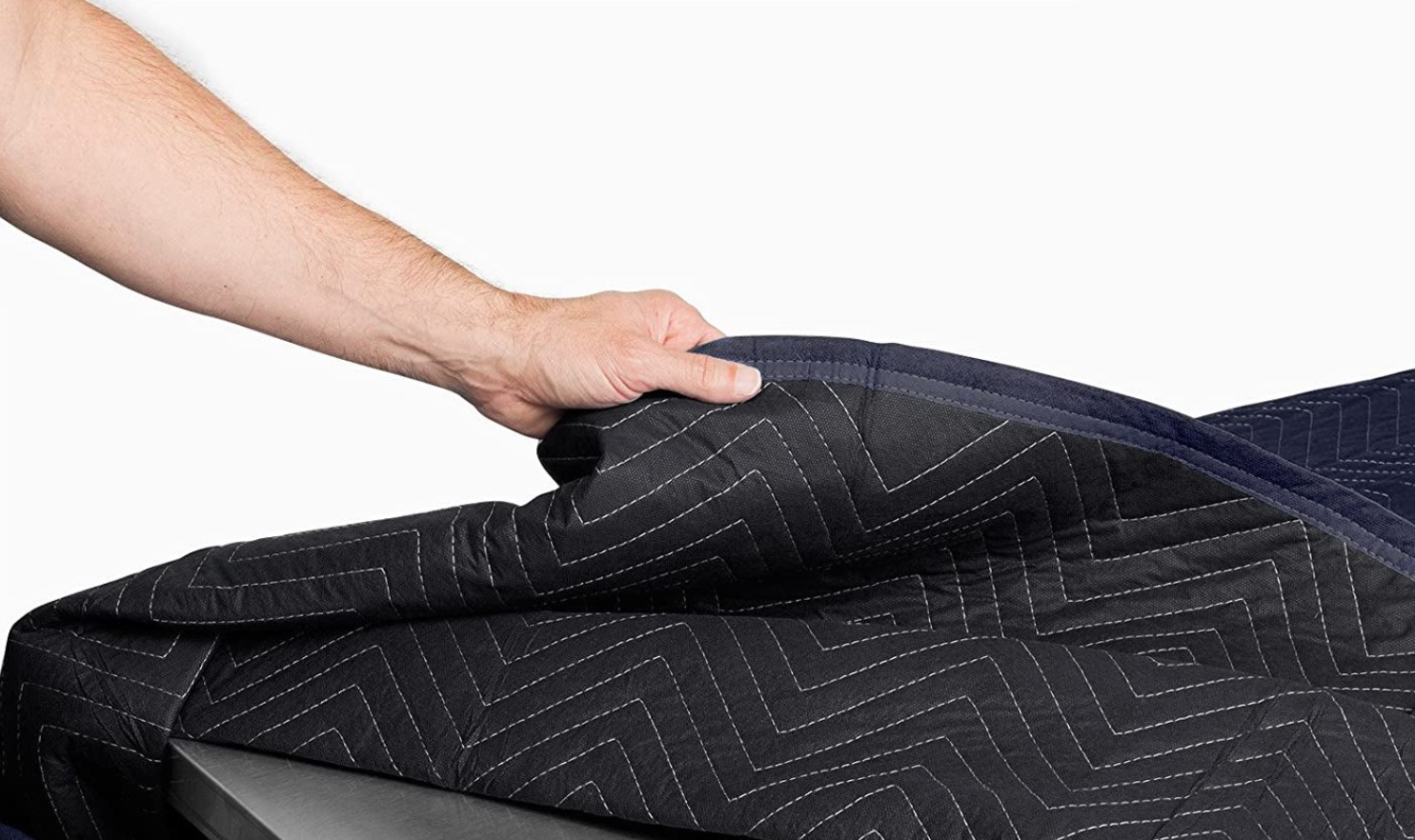Moving blankets are thick, protective coverings designed to shield furniture from scratches, dents, and other potential damages during a move. They act as a buffer, preventing furniture pieces from rubbing against each other or the walls of the moving truck. By following a few simple steps, you can effectively use moving blankets to safeguard your furniture and ensure a smooth moving experience.
Types of Moving Blankets
There are different types of moving blankets available, each offering varying levels of protection. Understanding the different options will help you choose the most suitable blankets for your specific needs.
- Durable woven moving blankets: These blankets are made from a strong and durable woven fabric, offering excellent protection against scratches and minor impacts. They are ideal for heavy or bulky furniture.
- Quilted moving blankets: Quilted blankets provide a higher level of cushioning and protection. They consist of multiple layers of fabric with padding in between. Quilted blankets are suitable for fragile and delicate items such as antique furniture or glass tabletops.
- Paper moving blankets: Although not as common as woven or quilted blankets, paper blankets are an eco-friendly option. They are made from recycled materials and are lightweight. While they may not offer as much protection as other types, they are still useful for covering lighter furniture pieces.
Choosing the Right Moving Blankets
To ensure adequate protection for your furniture, it is essential to choose the right type and quantity of moving blankets. Consider the following factors when making your selection:
- Assessing the level of protection needed: Evaluate the value and vulnerability of your furniture. Determine whether you need heavy-duty blankets for robust protection.
- Considering the size and weight of the furniture: Take into account the dimensions and weight of your furniture pieces. Larger and heavier items may require thicker and more substantial moving blankets.
- Budget considerations: Set a budget for your moving supplies, including the cost of moving blankets. Balance the quality and quantity of blankets with your budgetary constraints.
Preparing Furniture for the Move
Preparing furniture for the move is an important step in ensuring its safety during transportation. Start by thoroughly cleaning and dusting each piece to remove any dirt or debris. This helps prevent scratches and damage during the packing and moving process. Additionally, if your furniture can be disassembled, such as tables or bed frames, consider taking them apart. Disassembling furniture not only makes it easier to transport but also reduces the risk of damage during transit. Remember to keep track of any hardware or small parts and store them in labeled bags for easy reassembly.
Fragile items require extra care during the move. Before wrapping them with moving blankets, it’s advisable to wrap them individually with bubble wrap or foam padding. This provides an additional layer of protection against potential breakage. Pay special attention to fragile items like mirrors, glass tabletops, or delicate decor. Use caution when handling and packing them to prevent any damage. Take your time and ensure that each fragile item is securely wrapped and properly labeled to avoid any mishaps during the move.
As you prepare your furniture, it’s also important to consider the placement and arrangement of items within the moving truck. Plan the loading process strategically, taking into account the weight and size of each piece. Heavier and larger items should be placed at the bottom and against the walls of the truck to provide stability. Utilize furniture straps, ropes, or tie-downs to secure items in place and prevent shifting during transit. By properly preparing your furniture and strategically loading the moving truck, you can minimize the risk of damage and ensure a smoother moving experience.
Remember, taking the time to prepare your furniture before the move can save you from potential headaches and damages. It’s worth investing the effort to ensure that your furniture arrives at its destination in the best possible condition.
Wrapping Furniture with Moving Blankets
Now that your furniture is prepared, it’s time to wrap it with moving blankets:
- Start with large furniture items: Begin by covering your larger furniture pieces first, such as sofas, dressers, or dining tables. These items are more susceptible to scratches and dents during transportation.
- Secure the blanket with packing tape or straps: Lay the moving blanket flat on the floor or ground and place your furniture on top of it. Wrap the blanket snugly around the furniture, tucking in the corners as you go. Use packing tape or moving straps to secure the blanket in place.
- Pay attention to corners and edges: Ensure that all corners and edges of the furniture are properly covered and protected. These areas are particularly vulnerable to damage, so take extra care when wrapping them.
Securing the Moving Blankets
To prevent the moving blankets from shifting or falling off during transit, it’s important to secure them properly:
- Using stretch wrap to keep blankets in place: Stretch wrap is a plastic film that can be wrapped tightly around the furniture and moving blanket. This helps keep the blankets secure and prevents them from unwrapping or getting caught on other items.
- Securing the blankets with moving straps or ropes: For added security, use moving straps or ropes to secure the blankets further. Wrap the straps or ropes tightly around the furniture, ensuring the blankets remain in place.
- Preventing shifting and damage during transit: When loading the furniture onto the moving truck, be mindful of how the pieces are positioned. Distribute the weight evenly and utilize straps or ropes to prevent shifting and potential damage during transportation.
Loading and Unloading Furniture Safely
Loading and unloading furniture safely is crucial to prevent injuries and damages during a move. When it comes to loading, proper lifting techniques are essential. Remember to bend your knees, keep your back straight, and use your leg muscles to lift heavy furniture. Avoid twisting or jerking motions, as these can strain your muscles or cause back injuries. If possible, enlist the help of friends or hire professional movers to assist with the heavy lifting. Utilizing dollies or sliders can also make the loading process easier for large and bulky items.
When it comes to unloading furniture, take the same care and precautions as during the loading process. Communicate with your moving team to ensure everyone is on the same page and aware of the proper techniques. Prioritize safety by placing furniture in designated areas and avoiding obstructed pathways. If you encounter any challenges during unloading, such as tight doorways or narrow staircases, consider disassembling the furniture or seeking alternative methods to safely maneuver and transport the items.
It’s important to handle furniture with care during both loading and unloading. Delicate surfaces, such as polished wood or glass, should be protected with additional padding before moving. Take your time and work together as a team to ensure a smooth and accident-free process. By following these guidelines and prioritizing safety, you can minimize the risk of injuries to yourself and others, as well as prevent damages to your valuable furniture items.
Remember, if you’re unsure about your ability to safely load or unload furniture, it’s always a good idea to seek professional assistance to ensure a successful and injury-free move.
Storing Moving Blankets for Future Use
After the move, it’s important to store your moving blankets properly for future use:
- Cleaning and folding the blankets: Before storing the blankets, make sure they are clean and free from any dirt or debris. If necessary, wash them according to the manufacturer’s instructions. Once clean, fold them neatly to save space.
- Storing in a dry and pest-free environment: Find a suitable storage area that is dry, well-ventilated, and free from pests. Moisture and pests can damage the blankets over time. Consider using plastic bins or vacuum-sealed bags for added protection.
- Checking for any damages before reuse: Before using the moving blankets again, inspect them for any signs of damage, such as tears or frayed edges. Damaged blankets may not provide adequate protection and should be replaced.
Additional Tips for a Successful Move
Here are some additional tips to ensure a successful move:
- Labeling the wrapped furniture for easy identification: Use labels or markers to clearly indicate which room or area the wrapped furniture belongs to. This will make the unpacking process much easier and more organized.
- Protecting delicate surfaces with additional padding: For furniture with delicate surfaces, such as polished wood or glass, consider adding extra padding or foam sheets before wrapping them with moving blankets. This provides an additional layer of protection against scratches.
- Utilizing professional moving services if needed: If you have valuable or extremely fragile items, it may be worth considering professional moving services. They have the experience and expertise to handle delicate furniture and ensure its safe transportation.
Using moving blankets is an effective way to protect your furniture during a move. By choosing the right type of blankets, properly preparing your furniture, and securing the blankets in place, you can safeguard your valuable belongings from scratches, dents, and other potential damages. Remember to practice proper lifting techniques and communicate with your moving team to ensure a safe and successful move.
FAQs
- Q: How many moving blankets do I need for my move? A: The number of moving blankets required depends on the size and quantity of your furniture. As a general guideline, estimate about 1-2 blankets per large furniture item.
- Q: Can I reuse moving blankets? A: Yes, moving blankets can be reused multiple times. Just make sure to inspect them for any damages before reuse.
- Q: Are moving blankets waterproof? A: Most moving blankets are not waterproof. If you anticipate exposure to rain or moisture, consider using additional protective coverings such as plastic wrap or tarps.
- Q: Can I use old blankets or sheets instead of moving blankets? A: While old blankets or sheets may provide some level of protection, they are not specifically designed for moving purposes. Moving blankets offer better cushioning and durability.
- Q: Where can I purchase or rent moving blankets? A: Moving blankets can be purchased or rented from moving supply stores, home improvement centers, or online retailers specializing in moving supplies.

